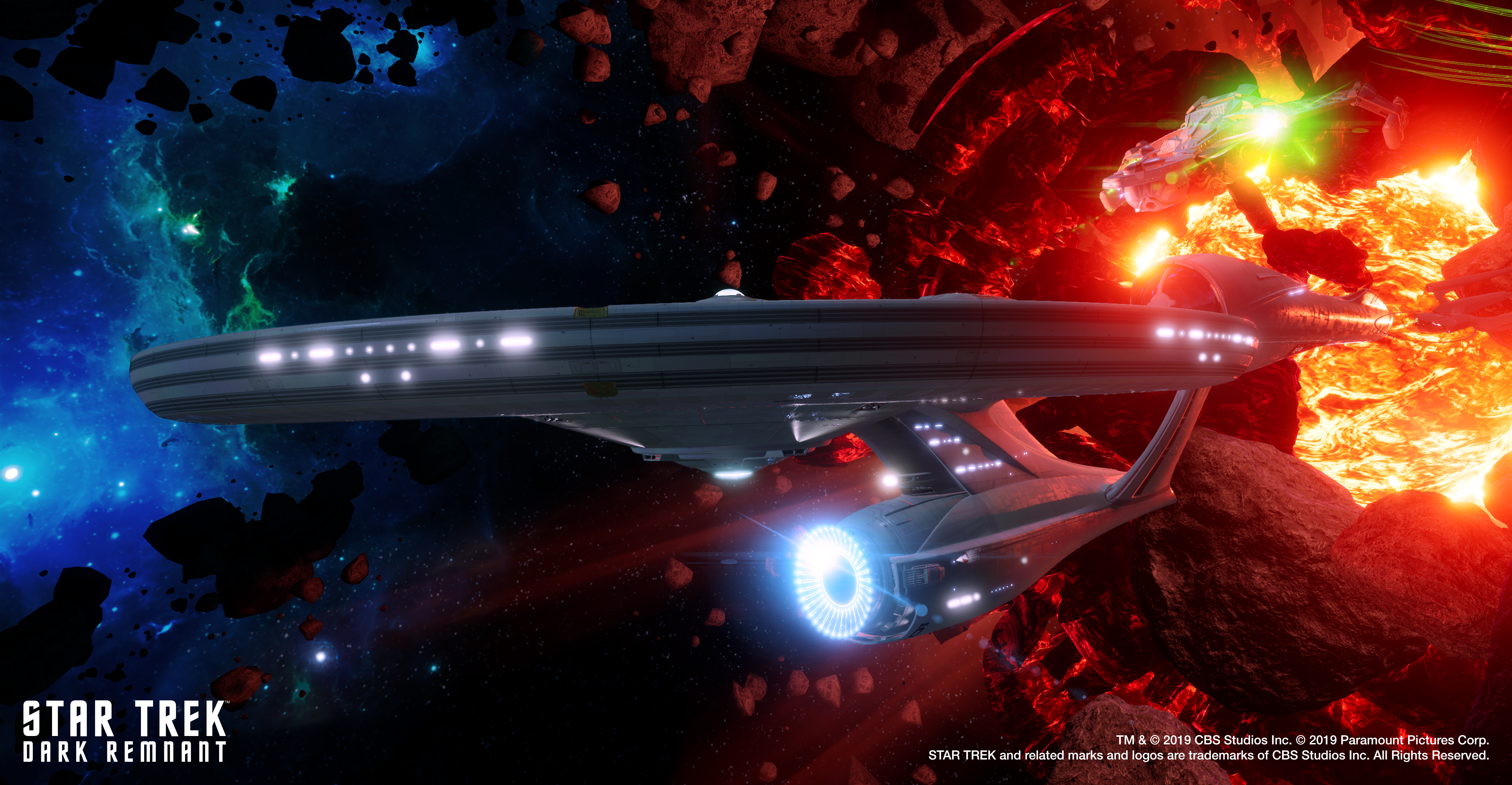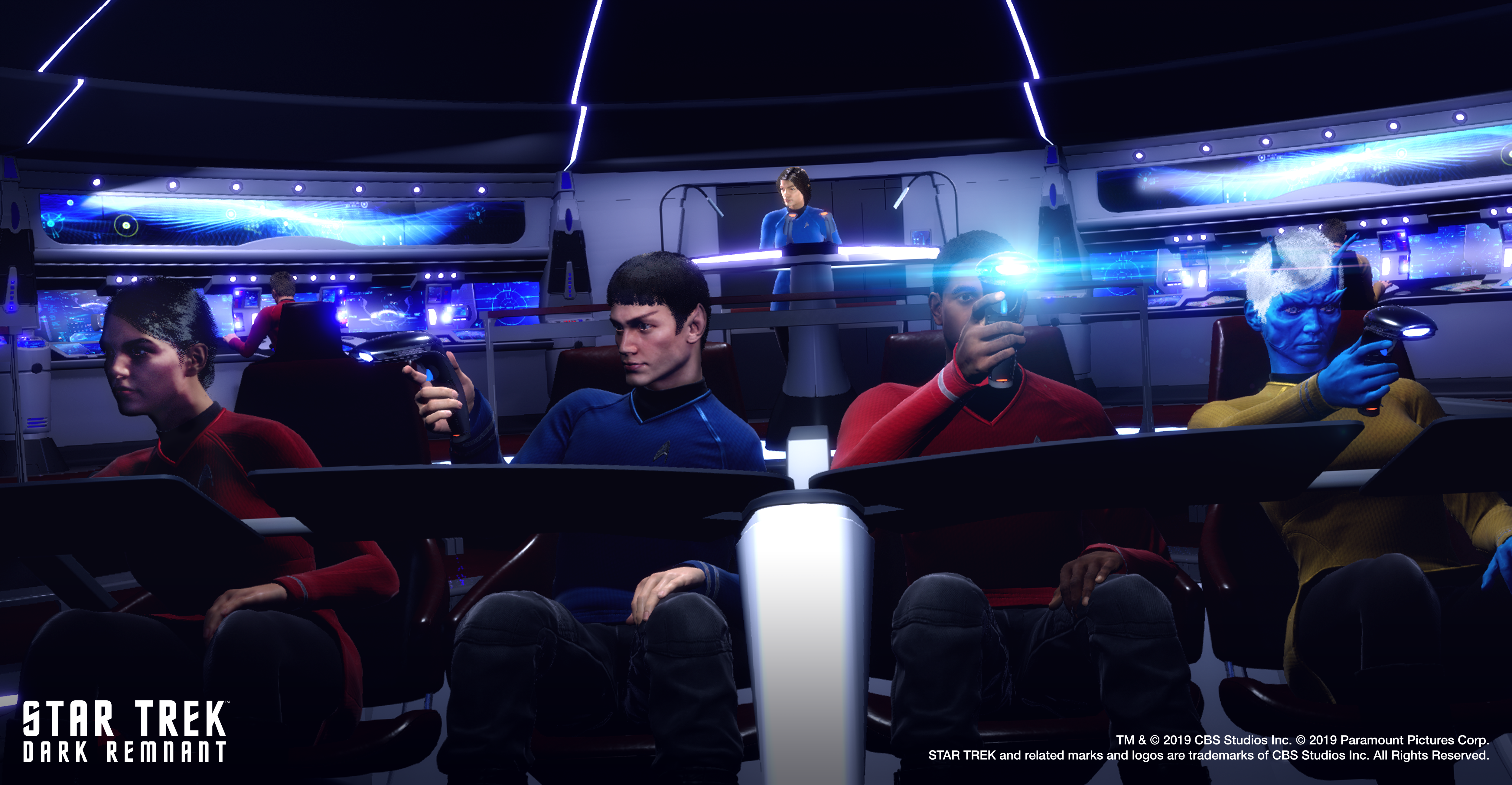Dave & Buster’s launched their 3rd experience “Star Trek: Dark Remnant”, at more than 120 locations across North America. Allowing players to rescue the “Enterprise” from space debris and evil Klingons, “Star Trek: Dark Remnant” puts up to 4 players aboard the U.S.S. Galileo, Starfleet’s newest and most advanced stellar research vessel that’s on a routine evacuation mission gone awry. The experience features multiple player characters and comes with different endings. Incorporating legacy assets from the film into their own SFX and music work, Hexany Audio took on the challenge of re-creating a legendary universe via their immersive and interactive audio work.

This is your third Dave & Buster’s LBE project. Were there any differences in how you collaborated with the other teams and stakeholders? At what point during development did audio come in?
Alex: This time around I personally, had a much more hands on collaboration than previous projects. I was involved with our weekly VRstudios and Strange Reptile audio calls alongside Richard Ludlow (Audio Director) and Bradan Dotson (Producer), and was able to give my feedback and input there. This helped make sure we weren’t missing anything that might have gone into the game, ultimately giving us a more rounded view of the project. Richard and Bradan focused more on the larger picture where I, being in the trenches, could focus on more of the details.
Audio came in basically as soon as things came online. We tried to stay on top of the audio needs, so we didn’t get blindsided by last minute additions and changes as deadlines approached.
How much creative freedom did you have re-creating such a legendary universe? What was your approach for getting started with such a project?
Alex: I had a good bit of creative freedom, which was really nice as lead sound designer. I obviously had to make sure it sounded like Star Trek, but getting Star Trek to translate to VR meant I had to make some decisions so it sounded as immersive as possible.
My general approach was to take the legacy sounds and keep the sounds as close to those as possible. If that didn’t work for whatever reason, I used those sounds as the base and built off of them or took my own approach using the original sounds as my sonic palette to draw from.
Did you have access to a repository of legacy assets to work with? Did you have to recreate any assets for creative or technical reasons?
Alex: Luckily, I had access to a good selection of the Abrams’ era assets. This gave me a really good starting place for most of the sounds. In the library there were a lot of ship sounds (warp-ins, pass-bys, cockpit UI beeps, etc), a good selection of blaster sounds, and a smattering of other sounds like ambiances, alarms, and telemetry sounds. The blasters I had access to though were handheld pistol type blasters, so I had to take a good number of creative liberties with the various ship weapons in the game. The legacy assets didn’t fully have the punch I was going for, making it feel like you’re in a large ship or being shot at by the Klingons. I used the blasters I had as a guide, but then had to take a few liberties and more or less completely redesign the ship weapons to make them feel like they were coming from a ship rather than a small pistol.
How did you go about balancing between layering legacy assets and new sounds tailored for this experience to ensure remaining sonically true, while also adding a level of immersion and believability?
Alex: The legacy assets, when available to me, were more or less the basis of all the sounds. If I could get away with it, I generally just did some minor processing and added environmental effects and sweeteners to make the sound work in VR. The Enterprise warping in is a good example of this. I more or less used the legacy sound as-is with some minor mix tweaks with compression and EQ. The sound was pretty dry however, so I layered on a few environmental sounds like some flanged explosion tails and really low-pitched animal vocalizations. This was to add a bit of a sci-fi explosion to fill in the space after the warp in, and to make it feel like the Enterprise came in a bit more violently, adding to the intensity of the moment.
For things like ambiances, I was able to take bits and pieces of the cabin interior sounds such as computers, telemetry sounds, etc., and blend them with my own sounds. Also, because the Galileo is a new ship, I needed to develop those SFX from scratch. The other engines in the Star Trek universe have a really iconic sound so I couldn’t just use those. I had to take the engine sounds which I had access to and analyze and deconstruct them a bit so that I could then make my own engine sound for the Galileo. This led to a good mix of sounds Star Trek fans know and love, mixed with a modern take on the new sounds while still feeling like Star Trek.
How did you prioritize your audio for this experience? Can you tell us a little bit about any systems you may have designed for it?
Nick: Since the experience allows for up to four players in the same world at once, we were able to give the local player priority over other players. This meant that in your “version” of the world, you’d hear your phasers firing over all the other players since we wanted you to feel the impact of your shots over other players. In a sense everyone had a mix tailored to their experience and actions.

How does the audio participate in guiding the player through this experience and directing their attention?
Alex: Voice over takes point here in guiding the player in Star Trek: Dark Remnant. We have a great number of lines to help guide the player to what they need to be paying attention to, while helping push the story along at the same time.
As far as sound design goes, a good chunk of the game is fairly linear. I could approach a few moments almost as if I were cutting sounds in a film. I was able to lead the player into larger moments like the star collapsing, adding rumble and sounds of the star becoming more and more unstable. Being able to turn your head in the headset meant that spatializing the sounds properly and making sure the player can hear the threats in the correct direction was key. The Klingon Battlecruiser cloaks and de-cloaks around a lot in the fight sequences and it was key to make sure that was spot on, in order to make sure the player can find the Klingons during the chaos of the fight.
Is there any formula you developed to balance between creating enough detail in the backgrounds and ambiances for immersion, while maintaining a clean mix towards a more cohesive soundtrack keeping the players focused on the most important elements of each scene?
Alex: We had a number of systems to make sure the player could get the information they needed to while still feeling immersive. The first being, while in the cabin all the spatialized ambiances like the computers are set using the azimuth parameter to become quieter if you aren’t focused on them. This way, especially in the beginning, the player has a bit more breathing room to look around and take in their surroundings and enjoy the ambiances, all while not crowding the mix when the gameplay takes over the player’s attention.
The Star Trek: Dark Remnant experience makes use of a proprietary simulator platform and HTC Vive headsets. What kind of special considerations did you have to make for this experience given that it is an out-of-home VR experience?
Alex: The biggest audio consideration I found was actually knowing that the environment at Dave & Buster’s is much louder compared to a person’s home. This meant that some of the more subtle and finer details I wanted to implement didn’t translate as well, so I had to focus on designing clear assets to really cut through the mix and then get out of the way.
Can you elaborate on how you leveraged object based vs. ambisonics towards creating a cohesive spatial mix for this experience?
Richard: Everything we did for the game was actually object-based—we didn’t use any ambisonics. Sometimes simple is effective, and it’s what ended up working best here for this project!
Nick: For the most part, all the sounds you heard were attached to an object in space. For the sounds that weren’t attached to anything, we used Wwise’s emitter with automation feature to manually place and move a sound around the world as if it were there with you.
Were there any particular creative or technical challenges you hit? If so, how did they influence any creative or technical decisions?
Alex: The biggest challenge for me is really based on the environment. Like I said earlier, the game being in Dave & Buster’s means that the mix had to be super clear in order to cut through a lot of the noise. Early on in the project, I was designing with too much unnecessary detail and had to redo and pull layers out of it to really clear things up. I realized that while a lot of the subtlety sounded great on my speakers during the designing process, it just got in the way when things were placed into the game.
What Wwise features if any were especially helpful in allowing you to realize your creative vision?
Nick: The Wwise Meter is probably my favorite thing about Wwise because you can attach a RTPC to it. I’m a huge fan of sidechain compression, so being able to apply that concept to more than just volume opens the door to a lot of possibilities. One of the ways we like to use it is to slowly reduce one shots over time if they are constantly being re-triggered. For example, if the player keeps using their phasers or shields over and over again, they’ll start to go down in volume until the player stops shooting and the meter resets. This gives more impact to the first shot while also creating space for other sounds and music.
What are you most proud of when it comes to this project?
Alex: My favorite part to design was the opening sequence heading into Act 2. I really gave a lot of love to that section, in order to draw the player into the story and set the tone of the game. The engine sound during the warp speed sequence is basically a Shepard tone, so I could leverage that increasing anxiety. At the same time, I could also give the player a strong sense of release as they left the warp sequence and saw the gorgeous vista of this unstable star. During all this, I again got to bring the tension up as the player got closer to it until it explodes, setting off the start of Act 2.
What was the most fun part of working on this project?
Alex: I had a lot of fun in the first stages of working on the game. That’s when I really had to learn and dial in the sound of the game. I had to find that balance of the iconic sound of Star Trek, while still giving me the space and freedom to add and augment as the game needed. The game gave me a lot of opportunities to design some really bombastic moments like a star exploding, a huge ship being destroyed, warp speed sequences, and more, which is basically any sound designer’s dream.
 |
 |
 |
| Richard Ludlow Audio Director, Owner | Alex Barnhart Sound Designer | Nick Tomassetti Technical Sound Designer |


Comments